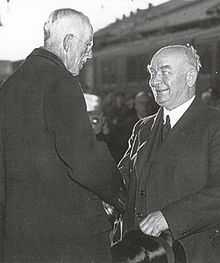Midsummer crisis

The Midsummer crisis (Midsommarkrisen) was a political crisis in Sweden that happened after the initiation of Operation Barbarossa and Nazi Germany attacked the Soviet Union on 22 June 1941.[1] Sweden's neutrality was tested when Nazi Germany with Adolf Hitler as a leader and Finland the same day demanded that Sweden should allow the neutralisation and transition of the 163rd Infantry Division (Wehrmacht) at a railroad between Norway and Finland, this led to Midsommarkrisen.[1] Following the German-Soviet invasion of Poland in 1939, Sweden's prime minister Per Albin Hansson declared strict neutrality and called for the formation of a broad coalition government involving all major parties under his leadership, which was realized in December except only the Communist Party.[2] Alone in Europe save for Spain, Portugal, Switzerland, Ireland and the Vatican, Sweden maintained neutrality throughout all World War II, but like the mentioned countries, cooperated and traded with both sides. Winston Churchill claimed that Sweden during World War II ignored the greater moral issues and played both sides for profit, a criticism mimicked in criticism towards Sweden's policy towards the German occupation of Denmark and Norway upheld partly by transportation reinforcement through Swedish territory, sanctioned by Hansson's cabinet.[3]
Evolution of the crisis
The German invasion of the Soviet Union on 22 June 1941, Operation Barbarossa sparkled an ultimatum by the government of Nazi Germany to Hansson's cabinet, demanding some military concessions, including German troop transports on Swedish railways in order to support Germany's ally Finland. Political deliberations surrounding this ultimatum have been dubbed the "midsummer crisis", which ultimately, allegedly following King Gustav V's decision to resign should the concessions not be made, fell out in favor of the Axis. The 83-year old king formally (although having not directly intervened in the government's policies since 1914) had the powers to appoint his own cabinet, and his open intervention in the issue was seen as a threat to the stability of the government and, given the ongoing war, to the sovereignty of the nation.
Recent research (2002) by Carl-Gustaf Scott argues however that there never was a "crisis" and that "the crisis was created in historical hindsight in order to protect the political legacy of the Social Democratic Party and its leader Per Albin Hansson." [4]
The Social Democratic Party and the Riksdag were divided on this question.[1] Per Albin Hansson gave the impression of the Riksdagsgroup that King Gustav V would abdicate if the question was denied and was successful in getting the group to make a decision that made it possible for the other parties to compromise.[5] One of the reasons to the approval was that Finland was expected to take a non approval in a bad way because its security relied on support from the outside, which only the Germans had granted.[5][6] German Foreign Ministry official Karl Schnurre told Swedish Minister of Foreign Affairs Christian Günther that Finland's security with an almost complete certainty would be drawn into the already weaponized conflict in Europe.[5] The 'Midsummer crisis' was very publicized in 1941, and was interpreted as a sign that King Gustav V had some personal responsibility for the weakness shown towards Nazi Germany.[5]
Confirmation of the King's action is contained in German Foreign Policy documents captured at the end of the war. On 25 June 1941, the German Minister in Stockholm sent a "Most Urgent-Top Secret" message to Berlin in which he stated that the King had just informed him that the transit of German troops would be allowed. He added:
The King's words conveyed the joyful emotion he felt. He had lived through anxious days and had gone far in giving his personal support to the matter. He added confidentially that he had found it necessary to go so far as to mention his abdication.[7]
According to Ernst Wigforss, both Gustaf V and Prince Gustav Adolf attempted to persuade the Swedish Government to allow the Allies to transport troops through Sweden, though this was rejected by the Government because it was felt it would cause retributions from Germany. Finland's neutrality declaration had no effect and the Soviet Union attacked the country with its military on 25 June.[6] The same day the transition of the railroad for the 163rd Infantry Division (Wehrmacht) was initiated.[1]
References
- ↑ 1.0 1.1 1.2 1.3 "Midsommarkrisen 1941". AH.se. Retrieved 21 June 2014.
- ↑ Socialistiska partiet Retrieved 21 June 2014
- ↑ Winston Churchill - The Second World War. ISBN 978-0-7126-6702-9
- ↑ Carl-Gustaf Scott, "The Swedish Midsummer Crisis of 1941: The Crisis that Never Was" Journal of Contemporary History, Vol. 37, No. 3, 371-394 (2002) (SAGE JOURNALS ONLINE)
- ↑ 5.0 5.1 5.2 5.3 "Om midsommarkrisen som skakade Sverige". Helsingborgs Dagbland. Retrieved 21 June 2014.
- ↑ 6.0 6.1 "Midsommarkrisen". AFW.se. Retrieved 21 June 2014.
- ↑ Documents of German Foreign Policy 1918–1945 Series D Volume XIII The War Years 23 June 1941 – 11 December 1941, Published in UK by HMSO and in US By Government Printing Office.